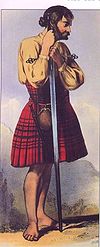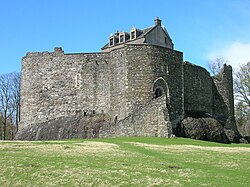|
Clan MacDougall
Clan MacDougall is a Highland Scottish clan, historically based in and around Argyll. The Lord Lyon King of Arms, the Scottish official with responsibility for regulating heraldry in Scotland, issuing new grants of coats of arms, and serving as the judge of the Court of the Lord Lyon, recognizes under Scottish law the Chief of Clan MacDougall. The MacDougall chiefs share a common ancestry with the chiefs of Clan Donald in descent from Somerled of the 12th century (and thus further of the Viking-born Norse-Gael dynasty of House of Ivar). In the 13th century the Clan MacDougall whose chiefs were the original Lords of Argyll and later Lords of Lorne was the most powerful clan in the Western Highlands. During the Wars of Scottish Independence the MacDougalls sided with the Clan Comyn whose chiefs rivaled Robert the Bruce for the Scottish Crown and this resulted in clan battles between the MacDougalls and Bruce. This marked the MacDougall's fall from power and led to the rise of their relatives, the Clan Donald, who had supported Bruce and also the rise to power of the Clan Campbell who were then the habitual enemies of the MacDougalls and later of Clan Donald. The MacDougalls supported the House of Stuart during the Scottish Civil War of the 17th century and during the Jacobite risings of the 18th century. HistoryOriginsThe Clan MacDougall takes its name from Dubgall (Dougall), the son of Somerled. After Somerled's death at the Battle of Renfrew in 1164, Dougall held most of Argyll as well as the islands of Mull, Lismore, Jura, Tiree, Coll and others.[4] The Celtic first name Dougall, or Dugald is derived from the Gaelic dubh-gall, which means dark foreigner.[4] Dougall's royal descent was acknowledged by the king of Norway and Dougall himself was styled as 'King of the South Isles and Lord of Lorne'.[4] One of Dougall's sons seems to have been Óspakr-Hákon, a man installed as King of the Isles by Hákon Hákonarson, King of Norway in 1230.[5] A certain son of Dougall was Duncan, who was in turn the father of Ewan. Duncan and Ewan built many castles to defend their territory.[4] These included Dunstaffnage Castle, Dunollie Castle and Duntrune Castle on the main land.[4] Whilst on the islands they built Aros Castle, Cairnburgh Castle, Dunchonnel Castle and Coeffin Castle.[4] Dunollie Castle is believed to have been fortified since the 6th century and became the seat of the chief of Clan MacDougall.[4] Duncan also built Ardchattan Priory and it was here that the MacDougall chiefs were buried until 1737.[4] Scottish-Norwegian WarEwan's possessions on the islands were held from the king of Norway, whilst his possessions on the mainland were held from the king of Scotland.[4] This made it hard for him to remain loyal to both.[4] In 1263 Haakon IV of Norway arrived with a huge fleet off the coast of Oban for an invasion of the west coast of Scotland.[4] However, Ewan decided not to join the invasion and thanks to old blood ties Haakon left him in peace.[4] The Battle of Largs then took place and Ewan joined the side of Scots and attacked part of the Norse fleet.[4] The Vikings were utterly defeated and three years later Norway ceded all of the Hebrides to Scotland.[4] Wars of Scottish Independence The MacDougalls' influence in Argyll brought them into conflict with the Clan Campbell.[4] In 1294 John MacDougall of Argyll led the Clan MacDougall against the Clan Campbell at the Battle of Red Ford, where Sir Colin Campbell was killed but there were considerable losses on both sides.[4] The fourth chief of Clan MacDougall married a sister of John Comyn II of Badenoch (the "Black Comyn"), whose son, John Comyn III (the "Red Comyn") was stabbed to death by Robert the Bruce in the church of Greyfriars in Dumfries in 1306, and this brought the MacDougalls into conflict with the Bruces.[4] The MacDougalls who had supported William Wallace in the cause of Scottish independence now found themselves in a blood feud with the Clan Bruce, whose cause was also of Scottish Independence.[4] Shortly after Robert the Bruce's coronation at Scone he was forced by the English to retreat into Argyll, in an attempt to reach his Clan Campbell allies.[4] However, the Clan MacDougall surprised the Bruce and defeated him in what was known as the Battle of Dalrigh.[4] The king escaped but left behind what was described as a magnificent example of Celtic jewellery, known as the Brooch of Lorne and it became one of the Clan MacDougall's great treasures.[4] Three years later Robert the Bruce led three thousand battle hardened veterans into Argyll against the MacDougalls.[4] John MacDougall of Lorne set an ambush for them but in the ensuing Battle of the Pass of Brander the MacDougalls were defeated and forced to flee.[4] The MacDougalls' lands were then forfeited by the king and he gave them to the Campbells for their loyalty.[4] Although the power of the MacDougalls was never regained, their fortunes were restored somewhat under John MacDougall's grandson, John Gallda MacDougall, Lord of Lorne. In the mid-14th century, the latter relocated from England to Scotland, married a niece of the reigning David II, King of Scotland, and regained the clan's ancestral lands in Lorne.[6] Most of their mainland lands were then returned in a royal charter from David II of Scotland.[4] Although the lordship of Lorne eventually passed into the hands of the Stewarts following John Gallda's death, the MacDougall chiefly line preserved through his son Allan.[6] 15th century In 1468 the Clan MacDougall fought against the Clan Stewart of Appin at the Battle of Stalc.[7][8] 17th century and Civil WarDuring the civil war of the 17th century the MacDougalls were generally royalists and chief Alexander MacDougall led five hundred of his clansmen into battle.[4] However, after the defeat of the royalist James Graham, 1st Marquess of Montrose, a Covenanter army, led by David Leslie, Lord Newark was sent into Argyll to deal with royalist supporters.[4] The MacDougalls lands were restored however, after the restoration on the monarchy in 1660.[4] 18th century and Jacobite risingsDuring the Jacobite rising of 1715 the Clan MacDougall supported the Jacobite cause and fought at the Battle of Sheriffmuir after which the chief was forced into exile but later returned to Scotland to live as a fugitive.[4] He was pardoned in 1727.[4] His son and next chief, Alexander MacDougall did not take part in the Jacobite rising of 1745.[4] However, his brother and some of the clansmen did indeed fight as Jacobites at the Battle of Culloden in 1746.[4] The fighting force of the clan at this time is given as 200 men.[9] ChiefThe current chief of the clan is Morag Morley MacDougall of MacDougall and Dunollie. She is a daughter of the sister of the previous clan chief, Coline Helen Elizabeth MacDougall of MacDougall and Dunollie. The latter was in turn a daughter of the previous chief, Alexander James MacDougall of Dunollie.[10] The chief of Clan MacDougall represents the senior line of Somerled's descendants.[11] The chief's coat of arms is blazoned: Quarterly, 1st and 4th, azure, a lion rampant argent; 2nd and 3rd, or, a galley sails furled sable, surmounted of a beacon gules.[12] This coat of arms specifically dates to 1931, and is very similar to one inscribed upon an 18th-century tombstone in the chiefs' Kilbride burial ground.[12][13] CastlesCastles built or owned by the Clan MacDougall have included amongst many others:   
Lords
Tartans
See alsoCitations
References
External links |
||||||||||||||||||||||||||||||||||||||||||||

